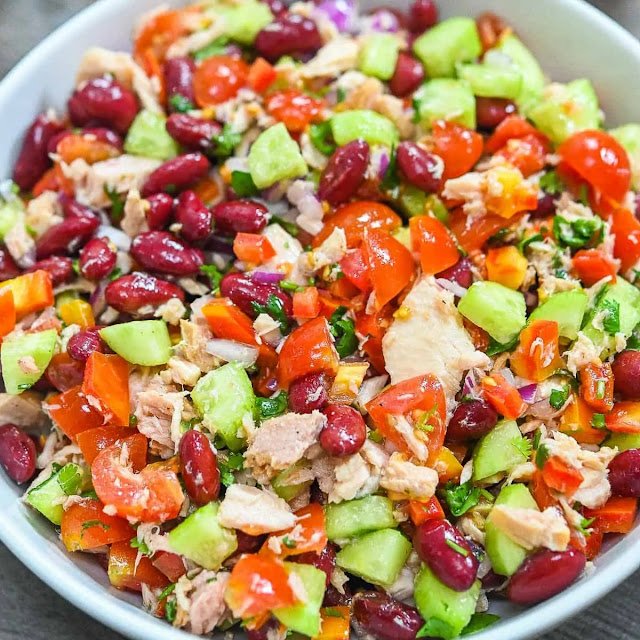Tuna salad is a versatile and delicious dish that is enjoyed by millions of people worldwide. It's a simple yet flavorful combination of canned tuna, mayonnaise, and other ingredients that can be customized to suit any taste or dietary preference. In this article, we'll take a closer look at what tuna salad is, its history, and some tips for making it.
 |
| TUNA SALAD |
What is Tuna Salad?
Tuna salad is a type of salad that is made with canned tuna, mixed with mayonnaise, and usually seasoned with salt and pepper. Other ingredients such as celery, onion, pickles, and herbs can be added to enhance the flavor and texture. Some variations may also include boiled eggs, avocado, or other vegetables. Salad is typically served chilled as a sandwich filling, as a topping for crackers, or as a salad over a bed of greens.
 |
| TUNA SALAD |
History of Tuna Salad
The origins of tuna salad are not well documented, but it is believed to have originated in the United States in the early 20th century. Canned tuna had become widely available and popularized during World War II, making it a convenient and affordable ingredient for households. As mayonnaise became more accessible, it was a natural pairing with canned tuna to create a tasty and filling sandwich filling.
 |
| TUNA SALAD |
Tuna Salad ingredients
Here are the common ingredients used to make tuna salad:
Canned Tuna - Tuna is the star ingredient in tuna salad, and canned tuna is the most convenient and affordable option. You can use either chunk or flaked tuna, packed in water or oil, depending on your preference.
Mayonnaise - Mayonnaise adds creaminess and richness to tuna salad. You can use either regular or light mayonnaise, or substitute it with Greek yogurt, sour cream, or avocado for a healthier version.
Celery - Celery adds crunch and a fresh flavor to tuna salad. You can chop it finely or into larger pieces, depending on your preference.
Onion - Onion adds a sharp, pungent flavor to the salad. You can use red, white, or green onions, and chop them finely or into larger pieces.
Pickles - Pickles add a tangy, salty flavor to the salad. You can use dill pickles, sweet pickles, or pickle relish, and chop them finely or leave them chunky.
Salt and Pepper - Salt and pepper enhance the flavor of the salad. You can add them to taste, depending on how much seasoning you prefer.
Other optional ingredients that can be added to salad include:
Hard-Boiled Eggs - Hard-boiled eggs add protein and a creamy texture to salad. You can chop them finely or slice them into rounds.
Mustard - Mustard adds a tangy, acidic flavor to the salad. You can use Dijon, yellow, or whole-grain mustard.
Lemon Juice - Lemon juice adds a fresh, citrusy flavor to the salad. You can use fresh or bottled lemon juice, depending on availability.
Herbs - Herbs such as parsley, dill, or chives can add flavor and freshness to the salad. You can chop them finely and mix them into the salad.
How to make the Best Tuna Salad
Ingredients:
- 2 cans of tuna, drained
- 1/2 cup mayonnaise
- 2 stalks of celery, diced
- 1/4 cup diced onion
- 1 tablespoon pickle relish
- 1 tablespoon Dijon mustard
- Salt and pepper to taste
Instructions:
In a mixing bowl, add the drained tuna, mayonnaise, diced celery, diced onion, pickle relish, and Dijon mustard.
Use a fork or a whisk to mix the ingredients together, making sure everything is well combined.
Taste the mixture and add salt and pepper as needed, depending on your preference.
Cover the mixing bowl with plastic wrap or transfer the salad to an airtight container and refrigerate for at least 30 minutes to allow the flavors to meld together.
Serve the salad as a sandwich filling, as a topping for crackers or toast, or as a salad over a bed of greens.
Tips:
- For a healthier version, use Greek yogurt instead of mayonnaise or a combination of both.
- Experiment with different herbs and spices to add more flavor, such as parsley, dill, or paprika.
- Use a variety of canned tuna, such as solid white or Albacore, for different textures and flavors.
- Add some crunch mix in chopped nuts, such as almonds or walnuts, or diced apples or grapes.
How to store Tuna Salad
Tuna salad should be stored properly to ensure food safety and maintain its quality. Here are some tips for storing salad:
Refrigerate immediately: Tuna salad should be refrigerated as soon as possible after it has been made or purchased. Leaving it at room temperature for an extended period can cause bacterial growth and spoilage.
Use an airtight container: Store tuna salad in an airtight container or cover it tightly with plastic wrap. This helps to prevent exposure to air, which can cause the salad to dry out and become less flavorful.
Keep in the fridge: Store the tuna salad in the refrigerator at a temperature of 40°F or below. The best place to store it is in the main compartment of the refrigerator, away from raw meats or any other food that may cause contamination.
Consume within 3-5 days: Tuna salad can be stored in the refrigerator for 3-5 days. After this period, it is best to discard any remaining salad, as it may not be safe to eat.
Do not freeze: Tuna salad does not freeze well and should not be stored in the freezer. Freezing can cause the salad to become mushy and lose its texture and flavor.
By following these storage tips, you can ensure that your salad stays fresh, safe, and delicious for as long as possible.
Is tuna salad healthy for health and its benefits?
Tuna salad can be a healthy and nutritious meal, depending on the ingredients used and the portion size. Here are some potential health benefits of salad:
Good source of protein: Tuna is a lean source of protein, and including it in your salad can help meet your daily protein requirements. Protein is essential for building and repairing tissues, maintaining muscle mass, and supporting healthy immune function.
Rich in omega-3 fatty acids: Tuna is a good source of omega-3 fatty acids, which are essential for brain and heart health. Omega-3s may also help reduce inflammation, lower blood pressure, and improve cholesterol levels.
Low in calories: Tuna salad can be a low-calorie meal option, especially if it is made with light mayonnaise or Greek yogurt. This can be beneficial for weight management and maintaining healthy body weight.
Contains vitamins and minerals: Tuna is rich in several essential vitamins and minerals, including vitamin D, vitamin B12, and selenium. These nutrients play important roles in supporting overall health and well-being.
However, it is important to be mindful of the ingredients used in salad. Some recipes may include high-calorie or high-fat ingredients, such as regular mayonnaise, which can negate the potential health benefits of the salad. Additionally, consuming too much tuna can lead to mercury poisoning, so it is important to limit intake to 2-3 servings per week, especially for pregnant women and children.
 |
| TUNA SALAD |
In summary, salad can be a healthy and nutritious meal option when made with wholesome ingredients and consumed in moderation.










0 Comments